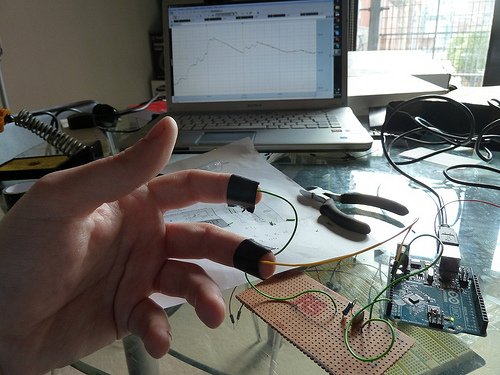Recently I’ve been looking at different ways of visualising physiological data, and have created a Poincare plot of a funfair ride at Southport PleasureLand I sampled last year. This form of visualisation plots current and successive heartbeats as x, y coordinates, so if a subject’s heartbeat was successively 70, 80 and 75 beats per minute (bpm) we would plot (70,80) and (80, 75) on an X-Y graph. In the instance below I’m plotting heartbeat activity as inter-beat interval which is the time between beats rather than the beats per minute. I’m particularly fond of Poincare plots as its easy to grasp a subject’s heart rate variability from casual inspection. At rest a subject’s heart rate variability should be high, and so individual beats should be spread out over the graph in somewhat of a noisily fashion. When stress is applied heart rate variability decreases and beats cluster.
Continue reading “Poincare Plots at the Funfair”
"Love is Over" – Gaming a Love Tester
Originally posted on PhysiologicalComputing.net.
Following on from my earlier adventure with the stress tester, sat right next door was a love tester, presumably developed by the same company given it was using the same chassis as the stress tester*. The love tester is probably one of the most familiar, and oldest, commercial biofeedback games around. Its function is to assess the sexual magnetism of the player using a comically named rating scale e.g. “Cold and Clammy” for no magnetism, “Out of Control” for lots. A love tester is basically a gag device which uses physiological input to provide some authenticity to the assessment. Their a common prop in media where making fun of the sexual prowess of a character is needed (e.g. The Simpsons); you can often find a love tester in a bar or the funfair if you want to try one out,
Continue reading “"Love is Over" – Gaming a Love Tester”
Post Oggcamp, GSR and Mama Horror Short
Last weekend I was at Oggcamp demoing a mobile GSR sensor using a mini-horror game I quickly whipped up for the event. The game uses a similar mechanic to Dark Escape 4D which I played a couple of months back. Dark Escape is a 2-player light-gun game with competitive biofeedback elements. During play there are several predetermined events which try to shock players into responding physiologically, and the player who responds the least is judged the winner. Its an interesting idea which lends itself well to an arcade game.
Continue reading “Post Oggcamp, GSR and Mama Horror Short”
Oggcamp, GSR and Horror Games
I’m off to Oggcamp tomorrow to demo a mobile GSR sensor. The device was originally commissioned by FACT (and built by Madlab) for an art exhibit I was involved in earlier in the year, however owing to time constraints we replaced the sensor for an off-the-shelf heart rate monitor. As the technical consultant involved in this venture the sensor has a couple of features I like in all my devices, such as being Bluetooth (easy to connect to) and a step counter (to manage data loss). I’m surprised how how many wireless sensors don’t provide a means to manage data loss, they just seem to assume their operating as a wired device which is the wrong assumption to make as research depending on time-locked signals becomes impossible. Continue reading “Oggcamp, GSR and Horror Games”
Playing Dark Escape 4D

Originally posted on PhysiologicalComputing.net.
Holidays and arcades are one of my traditions. Come every holiday I hole up in the nearest arcade and play games until my fingers go numb, usually from the re-coil of the light-gun games. Sadly, in my experience, arcade culture in the UK has diminished significantly as the novelty and variety of yesteryear is simply not there any more. Most arcades tend to host a mixture of dated racing and light-gun games (I’m looking at you Time Crisis), which, while were fun at the time have lost their charm. During my recent holiday, much to my surprise, I came across a brand new arcade game which really piqued my interest: Dark Escape 4D by Namco.
And why did this game catch my attention so, well because it was a biofeedback game, a biofeedback game at the ARCADE!
Continue reading “Playing Dark Escape 4D”
Working with Sensors: Transparency versus Quality Assurance

Originally posted on PhysiologicalComputing.net.
Recently I’ve been developing mechanics for a range of biofeedback projects, one of which was featured, over the summer, in an art exhibit at FACT Liverpool. These projects have been developed with the general public in mind, and so I’ve been working with consumer electronics rather than the research grade devices I normally use.
Continue reading “Working with Sensors: Transparency versus Quality Assurance”
Videos from Hack Yourself: Measuring Wellbeing
A full break down of the NESTA event can be found here. Videos over the page.
Continue reading “Videos from Hack Yourself: Measuring Wellbeing”
Panel Speaker – Hack Yourself: Measuring Wellbeing – May 3rd
I’m a panel speaker at the upcoming NESTA Hot topic event on “Hack Yourself Measuring: Wellbeing” in London on May 3rd. If your interested in talking about the Body Blogger project or Physiological Computing in general while I’m around drop me an e-mail.
Click here for event details.
Media Blowout
Trying to find free time to write something is always somewhat of an uphill challenge. In the meantime here a few links about my recent meanderings, enjoy!
- Interview in ACM XRDS Crossroads on EEG setups.
- Podcast by LJMU OpenLabs on Physiological Computing (for the transcript click here).
- Video presentation of my Quantified Self Europe talk – Lessons from a year of heart rate data.
- Photo series from BodyLab a business innovation event ran in-conjunction with LJMU Openlabs.
Reflections on Quantified Self Europe
Cross posted on PhysiologicalComputing.net
Last month I attended the inaugural Quantified Self Europe conference over in Amsterdam. I was there to present a follow-up talk to one I gave back in 2010 at Quantified Self London in which I described my experiences in tracking my heart rate along with publishing it in real-time over the Internet.
The Body Blogger system as it became known, after a term Steve came up with back in 2009, was only really intended to be used to demonstrate what could be done with the BM-CS5 heart monitors we’d recently purchased. As these devices allowed wireless real-time streaming of multiple heart rate monitors to a single PC there was a number of interaction projects we wanted to try out and using web services to manage the incoming data and provide a platform for app development seemed the best choice to realise our ideas (see here and here for other stuff we’ve used The Body Blogger engine for).
Continue reading “Reflections on Quantified Self Europe”